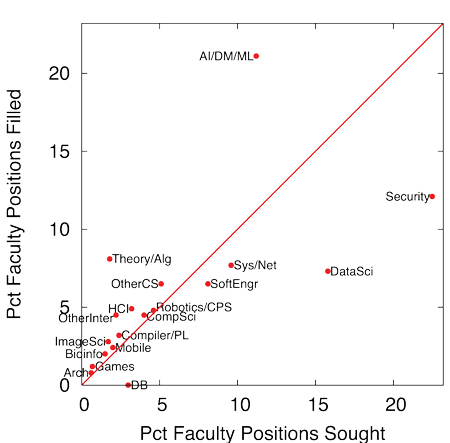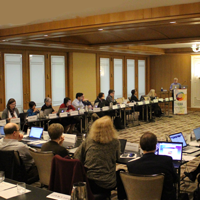Outcomes of Advertised Computer Science Faculty Searches for 2017
By Craig E. Wills, Professor and Department Head, Computer Science Department, Worcester Polytechnic Institute
This work directly follows previous work that analyzed current and future Computer Science needs via advertised tenure-track faculty searches for 2017. This follow-on work looks to understand the relative success of institutions in hiring the tenured/tenure-track faculty in the areas of Computer Science that were being sought.
Responses to a survey were obtained from 155 institutions that reported seeking tenure-track faculty in 2017. Survey respondents reported seeking 323 tenure-track faculty positions and filling 241 such positions for an aggregate success rate of 75%.
 The first accompanying graph shows the percentage of institutions with each level of search success based both on the number of positions sought and institution type. As shown, 18% of all institutions failed to hire any faculty, 29% were less than successful, 46% of institutional searches were a success and 7% were more than successful. The Top-100 PhD institutions had the smallest failed search rate of 9% while BS institutions had the highest failed search rate of 24%. Top-100 (57%) and BS (60%) institutions had the highest rate of hiring at least as many faculty as were being sought.
The first accompanying graph shows the percentage of institutions with each level of search success based both on the number of positions sought and institution type. As shown, 18% of all institutions failed to hire any faculty, 29% were less than successful, 46% of institutional searches were a success and 7% were more than successful. The Top-100 PhD institutions had the smallest failed search rate of 9% while BS institutions had the highest failed search rate of 24%. Top-100 (57%) and BS (60%) institutions had the highest rate of hiring at least as many faculty as were being sought.
Reported results on the previous position for hired faculty show that three types of such positions predominant. 31% of hired faculty start with a newly-earned PhD, 26% were previously in a post-doc/researcher position, and 26% were previously in a tenured or tenure-track position at another institution.
 The second accompanying graph compares the percentages for areas of filled positions with the areas in which positions were sought. It shows the clustered area of AI, Data Mining and Machine Learning showed the biggest positive difference with 21% of filled positions, but only 11% of sought positions. The Theory/Algorithms area showed the second biggest positive net percentage difference of 6% between percentage of positions filled and sought. In contrast, the area of Security showed the biggest negative difference with 12% of filled positions, but 23% of sought positions.
The second accompanying graph compares the percentages for areas of filled positions with the areas in which positions were sought. It shows the clustered area of AI, Data Mining and Machine Learning showed the biggest positive difference with 21% of filled positions, but only 11% of sought positions. The Theory/Algorithms area showed the second biggest positive net percentage difference of 6% between percentage of positions filled and sought. In contrast, the area of Security showed the biggest negative difference with 12% of filled positions, but 23% of sought positions.
Taulbee Survey results were used to compare areas of PhD production with areas of faculty positions sought and filled. Security is the area with most obvious discrepancy between percentage of PhDs produced (6%) and faculty positions sought (23%). AI/DM/ML and Security are the areas with the highest discrepancy between PhDs produced and positions filled with a net of 8% and 7% more positions filled than PhDs produced.
In summary, the results show a mix of success with just over 50% of institutions hiring at least the number of faculty they were seeking. In terms of areas, AI/DM/ML and Data Science collectively represent 28% of positions filled, although PhD production in these areas was not this high. There was much stronger demand for positions in Security than PhD production or positions actually filled.
The full report containing a description of the methodology and the complete results is available at http://www.cs.wpi.edu/~cew/papers/outcomes17.pdf.



